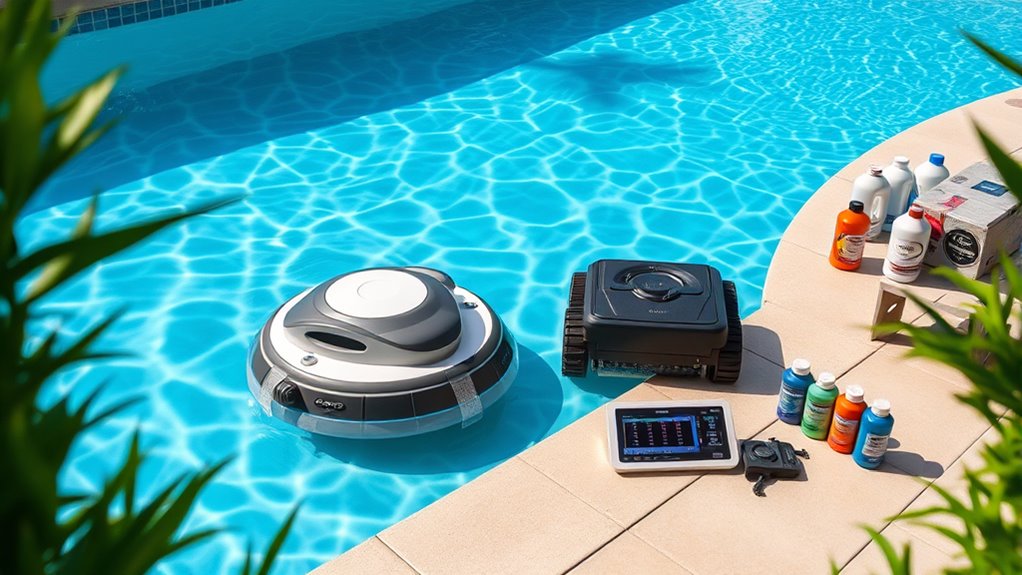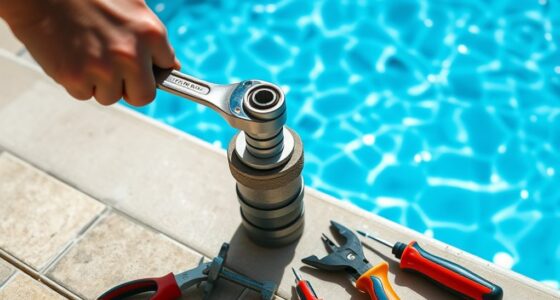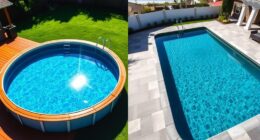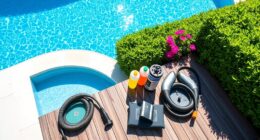To keep your pool in top shape year-round, create a scheduled routine that covers daily skimming, testing chemicals, and brushing walls, along with weekly checks of water levels and filter cleaning. Don’t forget monthly inspections of equipment and safety features. For seasonal changes, follow proper opening and closing procedures to protect your investment. Maintaining water chemistry and equipment is key. Keep going to find out more tips to make your pool care seamless all year long.
Key Takeaways
- Perform daily debris removal, water testing, and brushing to maintain water clarity and prevent algae growth year-round.
- Conduct weekly skimming, water level checks, and chemical adjustments for optimal water chemistry.
- Carry out monthly inspections of equipment, filters, and safety features to ensure proper functioning.
- Follow seasonal opening procedures to prepare the pool after winter and closing steps to protect it during off-season.
- Regularly secure and inspect pool covers, and clean the surface to prevent debris buildup and maintain safety.
Monthly Pool Maintenance Tasks
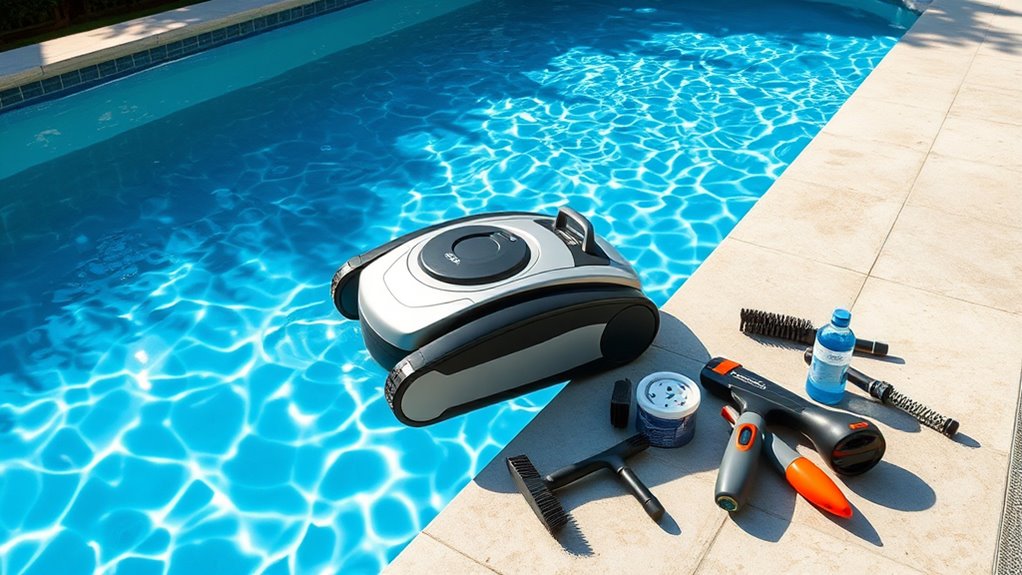
To keep your pool in top condition, you should perform certain maintenance tasks every month. Prioritize pool safety by checking that all safety features, like ladders and covers, are secure and functioning properly. Regular water feature maintenance is essential to prevent buildup of algae or debris that can compromise water quality. Clean out skimmer baskets and inspect the pool’s filtration system to ensure it’s operating efficiently. Test and adjust chemical levels to maintain proper pH and sanitizer balance, which supports safe swimming conditions. Additionally, monitor your pool’s water level and add water as needed. Regularly checking water chemistry helps prevent issues, keep your water safe and clear, and ensure all water features work smoothly, creating a safer, more enjoyable swimming environment. Incorporating proper maintenance schedules can extend the lifespan of your pool equipment and improve overall water quality. Understanding the importance of systematic care can lead to more efficient upkeep and fewer costly repairs over time. Staying informed about AI-driven platforms can also help you explore innovative tools for pool management and maintenance automation.
Weekly Pool Upkeep Checklist
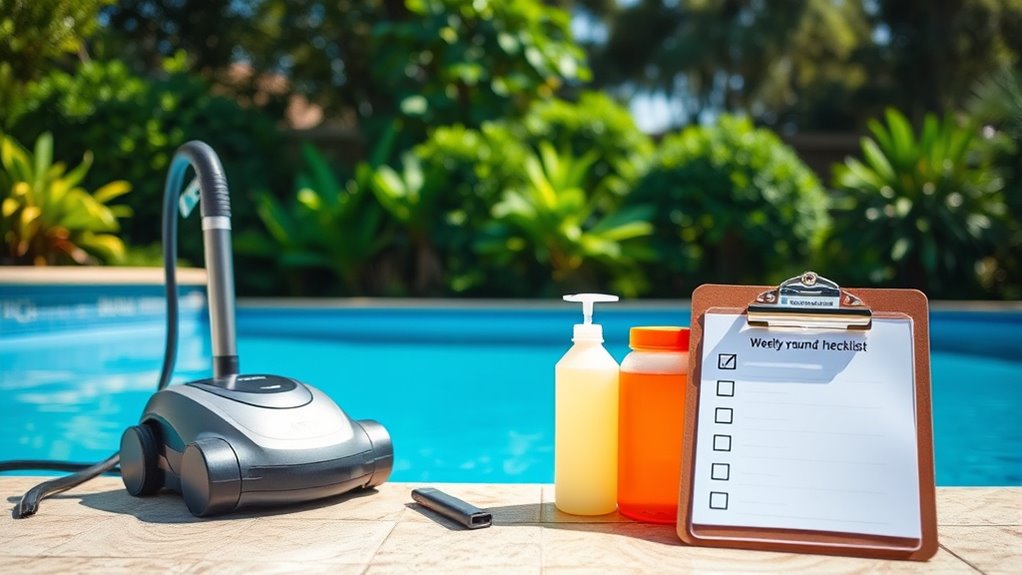
Maintaining your pool weekly helps keep it clean, safe, and running smoothly between your monthly tasks. Start by skimming the surface to remove leaves, insects, and debris that can hinder pool safety. Check and adjust the water level to ensure proper circulation and prevent filter damage. Test the chemical balance, focusing on chlorine and pH levels, to keep the water safe for swimmers. Clean the skimmer and pump baskets to maintain efficient operation. Don’t forget to inspect your pool landscaping; trimming nearby trees reduces debris and minimizes algae growth, supporting overall pool safety. Regularly brushing the walls and tiles prevents buildup and keeps the water sparkling. Ensuring proper air quality management around your pool area can also help reduce airborne pollutants and maintain a healthier environment. Proper vacuuming techniques, including using appropriate attachments, can further improve cleanliness and extend the life of your pool surfaces. Staying consistent with these weekly tasks ensures your pool remains inviting, safe, and well-maintained year-round. Incorporating hydration and nutrition into your routine can further enhance pool safety and overall well-being. Additionally, monitoring chemical levels consistently prevents issues before they arise, keeping your pool in optimal condition.
Daily Pool Care Essentials
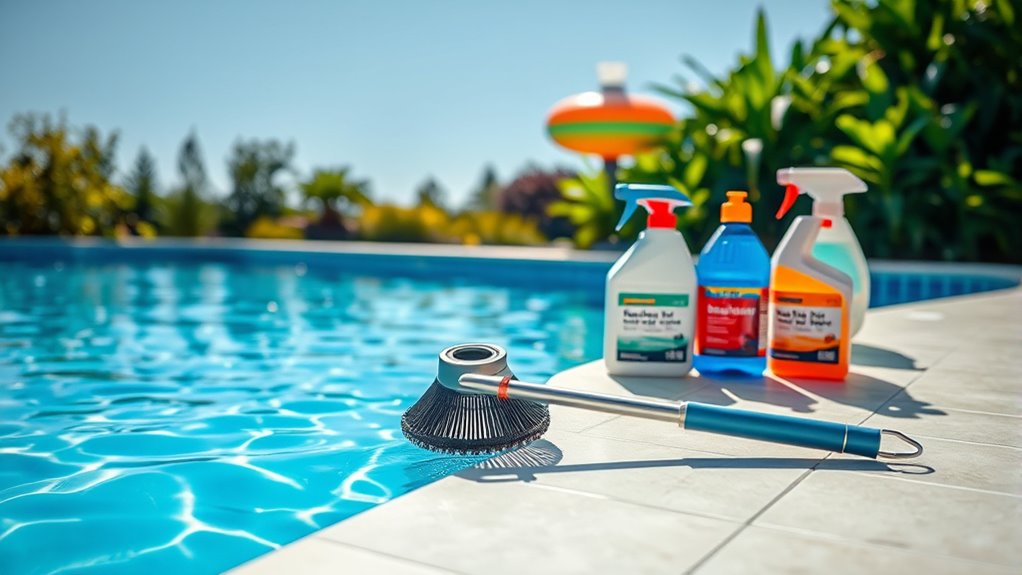
Since your pool is in constant use, staying on top of daily maintenance is essential to keep the water clean and safe. Check the skimmer and pump baskets daily to remove debris, preventing clogging and algae buildup. Test the water’s pH and chlorine levels regularly to maintain proper sanitation. Proper pump calibration ensures efficient filtration and prevents algae growth. Also, brushing the walls and floor daily helps prevent algae growth and keeps the water crystal clear. Incorporating regular gear inspection can help identify any equipment issues early, ensuring your pool remains in optimal condition. Additionally, monitoring water chemistry consistently is vital for maintaining a healthy swimming environment, especially when considering industry transformations like AI automation that can assist in pool management.
Seasonal Pool Opening Procedures
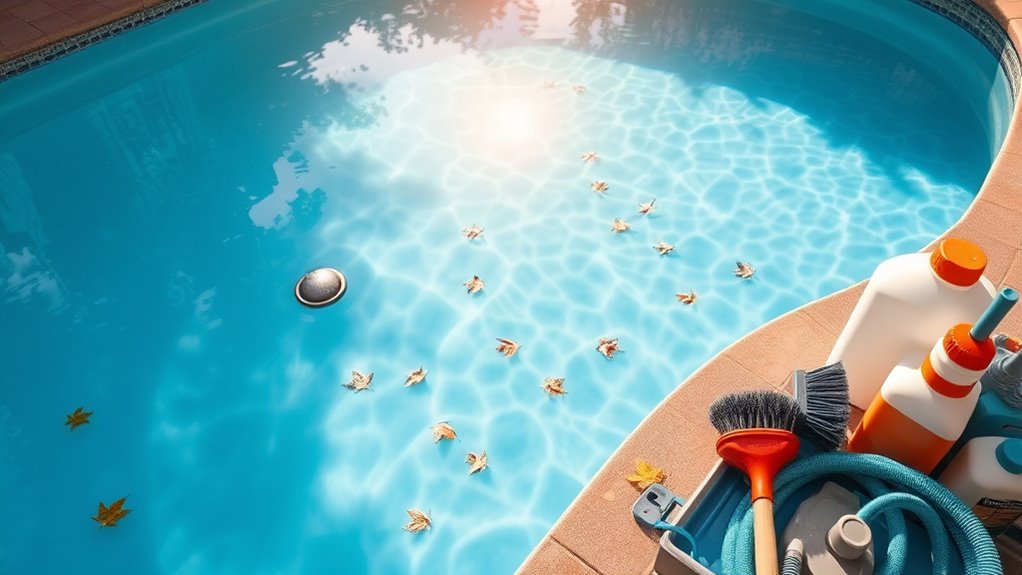
When opening your pool for the season, start by removing the cover carefully to avoid bringing debris into the water. Clear away leaves, dirt, and twigs from the cover before folding and storing it properly. Next, inspect the pool’s plumbing and equipment for any damages or leaks. Check your pool lighting to ensure it’s functioning correctly, replacing bulbs if needed, to enhance safety and ambiance. Balance the water chemistry by testing pH, alkalinity, and sanitizer levels, then shock the pool to prevent algae growth early on. Regular scrubbing and proper filtration are essential for algae prevention, especially after winter. Additionally, engaging with natural materials and tactile textures in Waldorf toys can inspire a gentle, sensory approach to maintenance routines, fostering patience and mindfulness. Proper pool maintenance routines help extend the lifespan of your equipment and keep your water sparkling. Incorporating routine inspections can also help identify potential issues early, saving time and costs later. Staying informed about sustainable materials in pool supplies can further enhance eco-friendly practices. Once the water is clear and balanced, turn on your equipment and enjoy a safe, inviting pool season ahead.
Seasonal Pool Closing Procedures
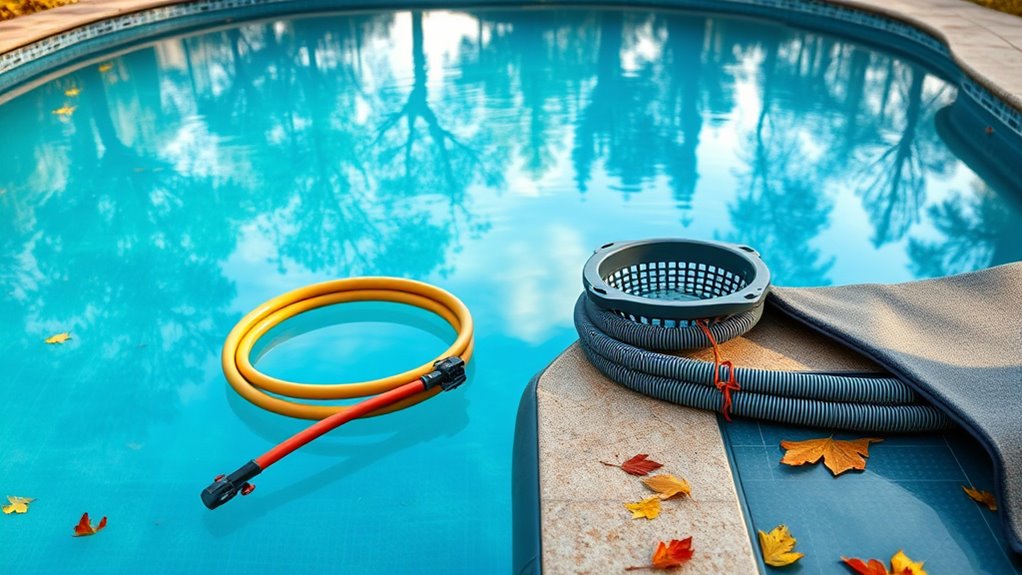
When closing your pool for the season, you’ll want to drain and clean it thoroughly to prevent buildup. Next, make sure to cover and secure the pool to keep debris out and protect it from the elements. Taking these steps now will help make certain your pool stays in good shape until spring. Additionally, consider reviewing your pool’s automation systems to ensure they are properly shut down and protected from potential damage during the off-season automation systems. Ensuring your cybersecurity measures are up to date can also help safeguard your pool controls from digital threats during the off-season. Implementing wealth protection strategies can further secure your investment in your pool equipment and property.
Drain and Clean Pool
Before closing your pool for the season, it’s vital to drain and thoroughly clean it to prevent damage and maintain water quality. Start by using a pool drain to remove remaining water, making certain all excess is cleared from the basin. Next, perform an all-encompassing pool cleaning, scrubbing the walls and floor to eliminate dirt, algae, and debris. Pay special attention to skimmer baskets and filters, removing any buildup. Proper drainage prevents freezing damage and helps avoid stains or cracks caused by stagnant water. Cleaning ensures the pool is free of contaminants that could cause problems during the off-season. Regular maintenance, including filter replacement, is essential to keep the pool in optimal condition. Additionally, inspecting the pool equipment ensures all components are functioning properly before winterization. Conducting a comprehensive inspection can help identify potential issues early and prevent costly repairs later. Taking these steps now simplifies reopening your pool later and keeps it in top shape through the off months. Proper drain and cleaning are vital for a smooth seasonal closure, and implementing preventative measures can further protect your pool during the off-season.
Cover and Secure Pool
To protect your pool during the off-season, you need to cover and secure it properly. Start by choosing a durable pool cover that fits your pool size and shape. A quality pool cover prevents debris, dirt, and critters from entering, reducing the cleaning workload later. Secure the cover tightly using straps, anchors, or clips to ensure it stays in place despite wind or weather. Proper pool security also involves removing ladders, diving boards, and any accessories that could cause damage or pose safety risks. Inspect the cover regularly during the off-season to check for tears or looseness. Additionally, incorporating essential oils for pool maintenance into your routine can help keep the pool environment fresh and free from microbial growth. Using proper pool chemistry is also crucial for maintaining water quality and preventing algae growth during the closed season. Securing your pool with a reliable cover and ensuring proper pool security keeps your pool protected, extends its lifespan, and makes opening up easier when swimming season returns.
Water Quality Testing and Adjustment
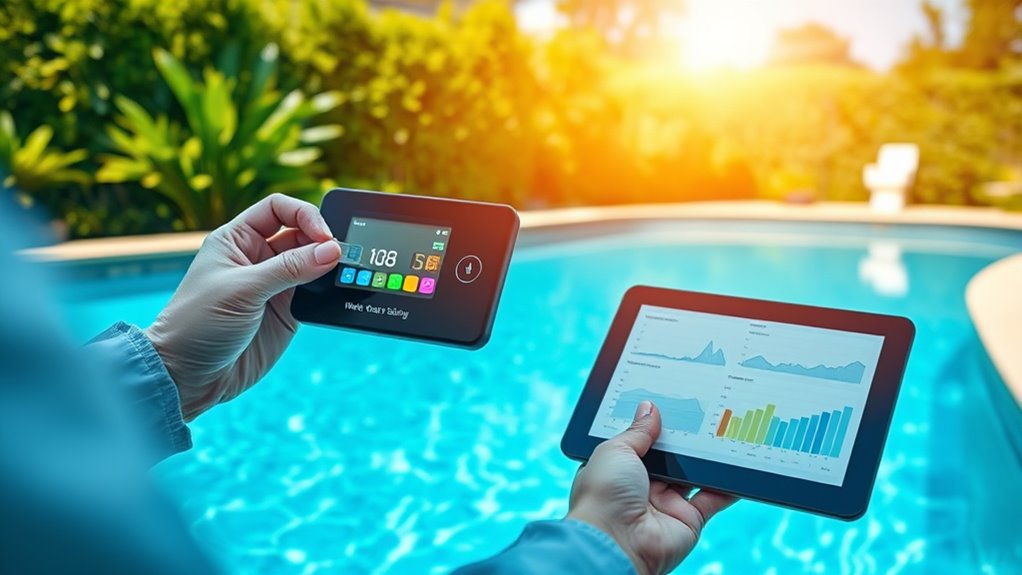
Regular water quality testing is essential to maintaining a healthy and safe pool environment. When you test, you’ll check key parameters to ensure proper chemical balancing and pH regulation. Imagine yourself:
- Using test strips or a liquid kit, you collect a water sample from the pool.
- You compare the color change to a chart, revealing levels of chlorine, pH, and alkalinity.
- Based on the results, you add the necessary chemicals—such as pH increasers or decreasers—to keep the water balanced.
- Incorporating proper maintenance routines helps prevent common pitfalls like overexposure to chemicals or neglecting regular testing.
Equipment Inspection and Maintenance
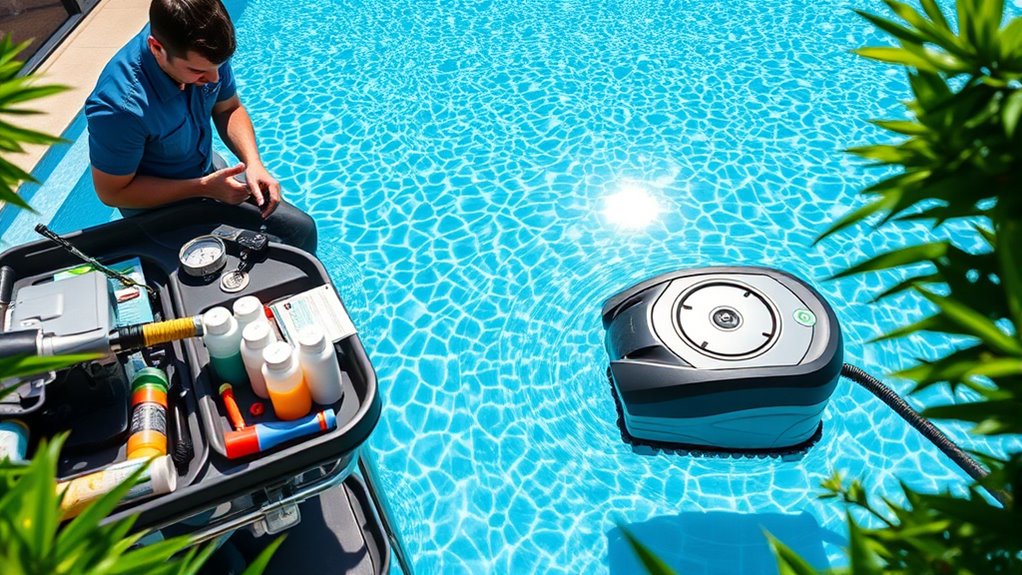
Maintaining clean and well-functioning pool equipment is essential to keeping your pool running smoothly and safely. Regularly inspecting your pool equipment helps catch issues early before they escalate. Use an inspection checklist to review key components like pumps, filters, skimmers, and valves. Check for leaks, unusual noises, and corrosion, ensuring all parts are secure and functioning properly. Clean or replace filters as needed to maintain water flow and quality. Inspect the electrical connections for signs of wear or corrosion, and ensure timers and control systems operate correctly. Keeping your pool equipment in top shape minimizes breakdowns and prolongs its lifespan. Schedule inspections at least monthly and after heavy use or storms to ensure your pool remains safe and efficient year-round.
Managing Pool Chemicals Year-Round
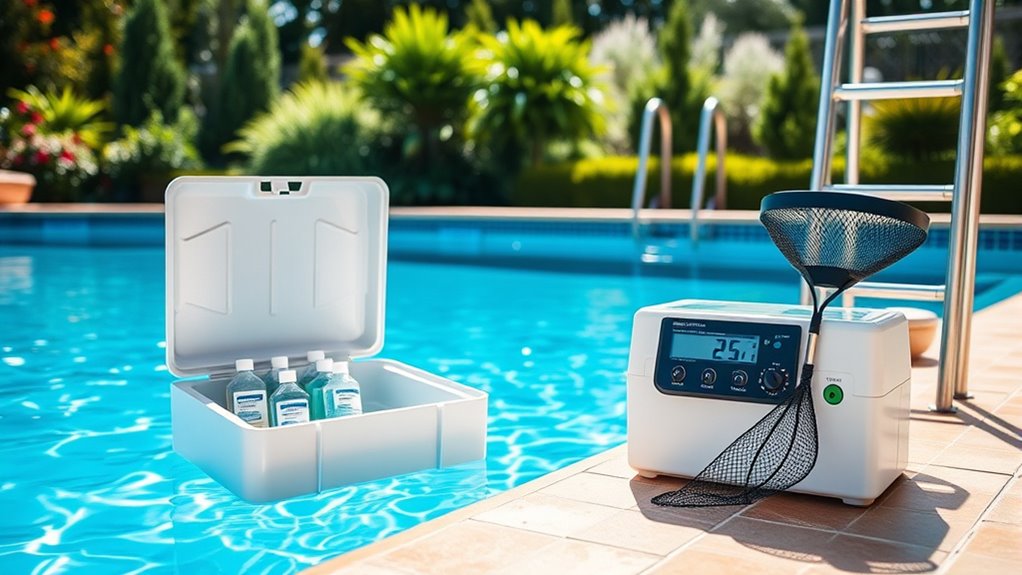
Managing pool chemicals year-round is essential for maintaining safe and balanced water quality regardless of the season. You’ll need to focus on:
Year-round pool chemical management ensures safe, balanced water for enjoyable swimming all seasons.
- Regularly testing water to monitor chemical balance, ensuring everything stays safe.
- Adjusting pH levels to prevent corrosiveness or cloudiness.
- Adding the right chemicals—such as chlorine or algaecides—to keep bacteria and algae at bay.
Consistently checking and adjusting pH regulation helps prevent water from becoming too acidic or basic. Maintaining proper chemical balance ensures your pool stays inviting and safe to swim in. During colder months, monitor chemical levels less frequently but don’t neglect them. Year-round chemical management keeps your pool in top shape, reducing long-term problems and making pool ownership hassle-free.
Cleaning and Skimming Tips
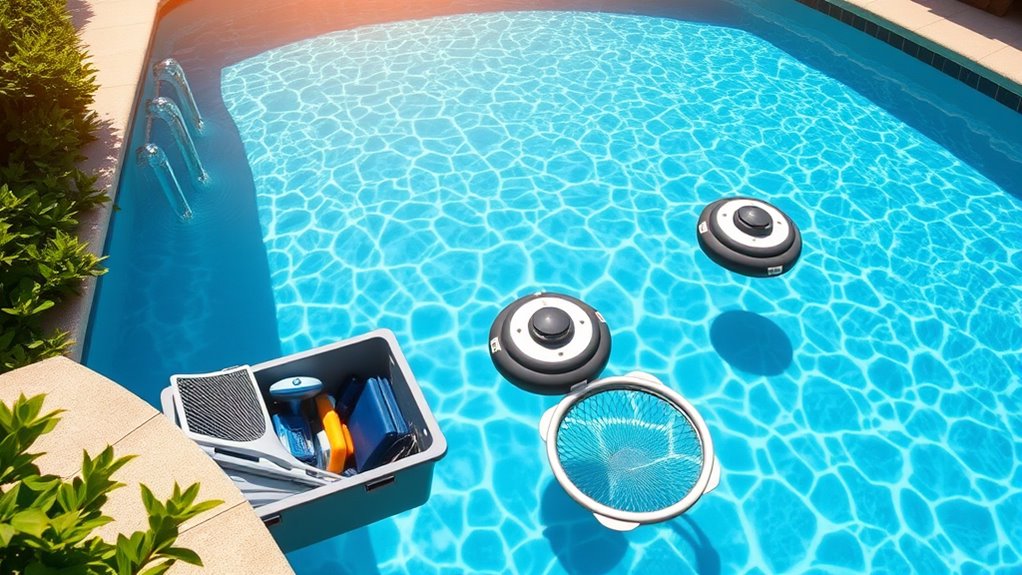
Keeping your pool clean and free of debris is essential for safe swimming and overall maintenance. Regular pool cleaning prevents algae growth and keeps the water sparkling. Use effective skimming techniques daily or as needed, focusing on removing leaves, bugs, and other debris from the surface. A mesh skimmer net makes this task easier and more efficient. When skimming, move smoothly across the water, paying attention to corners and edges. For deeper cleaning, use a pool brush to scrub walls and steps. Consistent skimming and pool cleaning help maintain water clarity and reduce chemical usage. Remember, quick daily efforts save you time and effort later, ensuring your pool stays inviting and safe all year round.
Troubleshooting Common Pool Issues

When you notice issues with your pool, quick troubleshooting can save you time and prevent more serious problems. Start by identifying common issues:
- Algae growth: You might see a green tint or slimy surface. To combat this, improve algae prevention by balancing your pool’s chemistry and running the filter longer.
- Poor water circulation: If the water isn’t circulating properly, check your pump. Troubleshoot the pump by inspecting for clogs, leaks, or malfunctioning parts.
- Cloudy water: This often results from inadequate filtration or imbalanced chemicals. Clear it up by cleaning your filter and testing your water’s pH and chlorine levels. Addressing these issues promptly keeps your pool clean, safe, and enjoyable.
Frequently Asked Questions
How Do I Prevent Algae Growth During Off-Season Months?
To prevent algae growth during off-season months, focus on algae prevention by maintaining proper water balance and cleaning your pool regularly. During off season maintenance, keep the pool covered when not in use and run the pump periodically to circulate water. You should also adjust chlorine levels to prevent algae spores from settling. Consistent upkeep and monitoring help keep algae at bay, ensuring your pool stays clean and ready for use.
What Are the Signs of Equipment Failure Outside Scheduled Maintenance?
Imagine your pool equipment as the heart of your oasis, quietly working beneath the surface. When failure happens, you may notice unusual noises or equipment inspection reveals vibrations or leaks. These signs signal trouble, like a heartbeat irregularity. Stay vigilant, listening for strange sounds and checking for leaks or corrosion. Promptly address these issues to prevent costly repairs, ensuring your pool remains inviting and safe year-round.
How Can I Reduce Chemical Usage in Winter Months?
To reduce chemical usage in winter months, consider using natural sanitizers like mineral or ozone systems, which lower the need for chlorine. Regular pool cover maintenance helps keep debris out, reducing contamination and chemical demands. Guarantee your cover stays clean and fits well, so your pool stays protected. These steps maintain water quality efficiently, saving you chemicals, money, and time during the colder months.
Are There Eco-Friendly Pool Maintenance Options Available?
Thinking of your pool as a living ecosystem, you can embrace eco-friendly options like solar heating to harness the sun’s gentle warmth and natural filtration systems that work with nature rather than against it. These choices reduce chemical use and energy consumption, creating a sustainable oasis. By integrating solar panels and biological filters, you’re nurturing your pool while protecting the environment, turning maintenance into an act of eco-conscious care.
How Do Temperature Changes Affect Pool Chemical Balance Year-Round?
Temperature fluctuations can substantially impact your pool’s chemical stability throughout the year. As water warms or cools, it can cause chemicals like chlorine to break down faster or become less effective. You need to regularly test and adjust your chemical levels to maintain proper balance, especially during seasonal changes. Staying attentive to these temperature shifts helps keep your pool clean, safe, and properly sanitized all year round.
Conclusion
Maintaining your pool year-round keeps it inviting and safe. Did you know that regular upkeep can reduce chemical costs by up to 30%? Staying consistent with your schedule guarantees crystal-clear water and extends your pool’s lifespan. By following these tips and routines, you’ll enjoy hassle-free swimming all year long. Remember, a little effort now saves time and money later, making your pool the perfect summer escape whenever you want.

